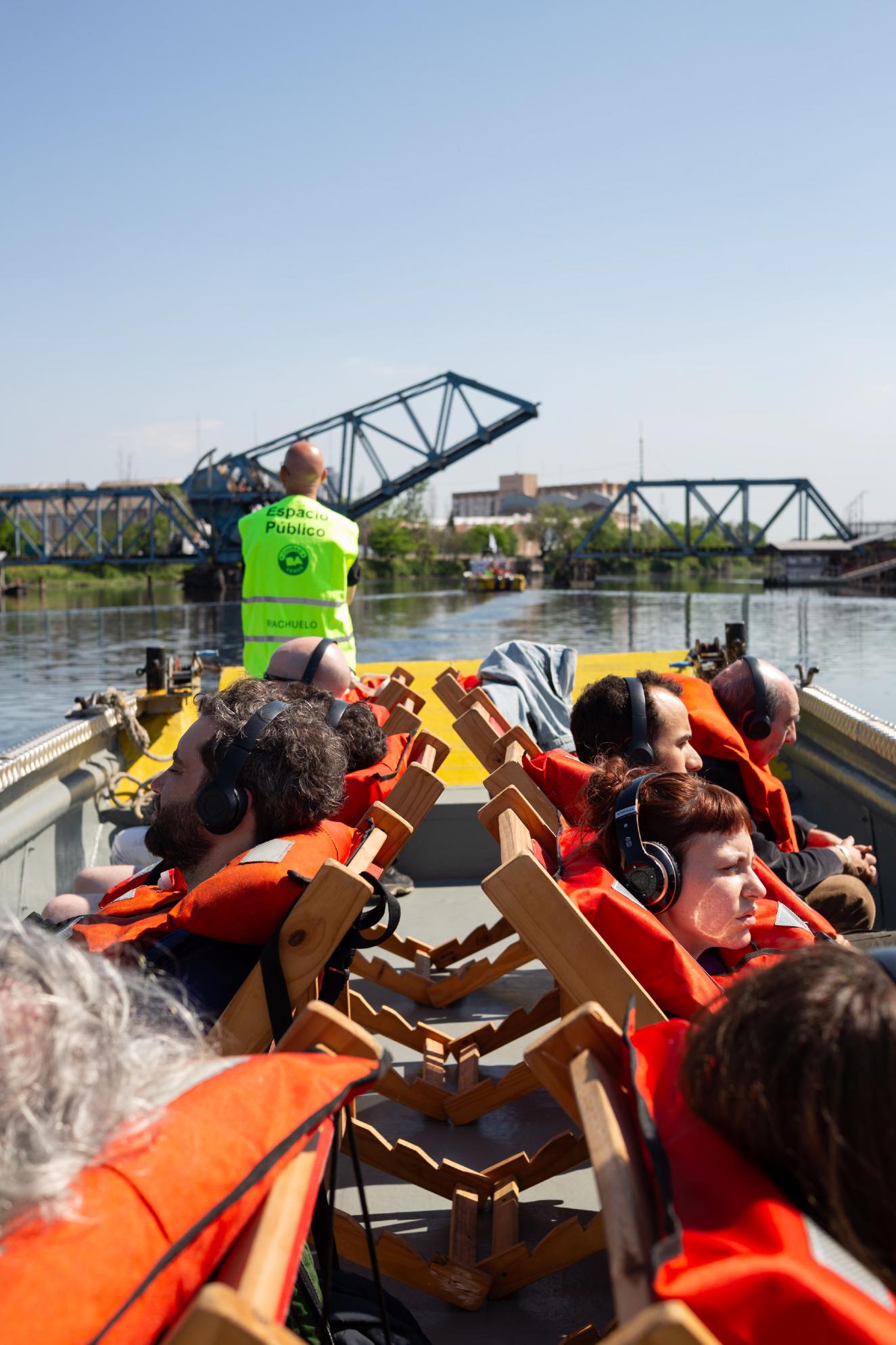

Navigating the Anthropocene
On the Riachuelo
October 2024- July 2025
Text-Clément Layes/ Aime C. Songe
With the support of Ana Laura López de la Torre
Photography: Tammo Walter

Riachuelo Matanza
History and Geography
The Riachuelo is a short river, measuring 64 km. Its source is surrounded by pampas and fields; about the spring someone told us: "It's nothing, just a muddy puddle." As the river descends the nearly imperceptible slope toward the Río de la Plata, many small tributaries join it. Together, they form the Matanza-Riachuelo basin. This basin is home to over 6 million people, roughly 15% of Argentina’s population. The river crosses fourteen municipalities in the Buenos Aires province. Along its course, it passes through rural and urban landscapes. In the capital, the river is bordered by industries and poverty. Over 10,000 factories and many popular neighbourhoods, including the infamous “Villa 21-24” (shantytown). La Boca, near the delta, was the historic port of entry of Buenos Aires, the point of arrival and departure for migrants and goods. Not long after, the Riachuelo empties into the Río de la Plata, a vast "sea-river," as Uruguayans sometimes call it, that collects the waters of a quarter of the South American subcontinent and flows into the Atlantic Ocean.
The Riachuelo is one of the most polluted river in south America, but imagine a not-so-distant time before colonisation when we could see the river shining in its curves and meanders, surrounded by marshes, riparian forests, with small groups of Querandíes camping along its banks. The Guaraní call the river “Iberá,” meaning “shining water.” Since the 18th century, tanneries, slaughterhouses, and salting plants have proliferated along its course, with animal carcasses floating in blood dumped into the river by tanneries. Perhaps that’s why the river was named “Matanza” (murder), or because crimes were committed here against indigenous populations. Later, freezing factories appeared, adding chemical pollution to organic waste. The 20th century saw the arrival of more factories along the Riachuelo’s banks, leading today to toxicity levels exceeding 50% of the permitted thresholds for arsenic, mercury, lead, and zinc, causing skin and respiratory diseases among residents. Organic pollution depletes the river’s oxygen, rendering it nearly dead.
Some meanders of the river have been straightened, and marshes filled and built over, with no solutions for water drainage during heavy rains, increasing flooding in the impoverished neighbourhoods along its course. This process was common in many rivers during industrialisation, here it seems it was never halted or slowed—Argentina was too preoccupied with economic imperatives, then dictatorship came and successive recessions arrived making it secondary to combat this scourge. The river was considered lost—a rubbish dump—and residents saw it as a trash.
In the 20th century, the port was moved southward to the Río de la Plata to accommodate deeper ships. Pollution increased with this abandonment, and shipwrecks multiplied. Until 2008, the area was devastated—a sacrificed zone. Those who knew it say that crossing the river meant passing through its smell, which lingered far behind.
In the 2000s, residents of the most polluted zone of the river, the “flammable” villa near chemical oil industries that dumped major pollutants with impunity, organised themselves. Years of citizen action led to a significant trial for environmental defence, now known as the Mendoza case. New, complex ways of understanding the Riachuelo and its ecosystem had been open through social and interspecies solidarity.
On October 8, 2008, the judge of the Mendoza case ordered the implementation of a recovery plan for the Riachuelo. Interestingly, the ruling in favour of the activists—rare in Argentine courts— was influenced by a highly publicised conflict between Argentina and Uruguay, called the “paper war,” over another river: the Uruguay River, which forms a border between the two countries. Since 2006, Argentina had challenged Uruguay’s construction of a paper mill, accusing Uruguay of significant pollution risks. This conflict had escalated, with militants blocking bridges and the

military were called in. This context led Argentinian judges to side with environmental activists: the country could not denounce Uruguay’s pollution while permitting pollution in the Riachuelo.
The rejuvenation plan for the Riachuelo included constructing an underground canal for wastewater, building a treatment plant (which was recently suspended by the government), creating treatment stations for industries, banning toxic discharges, and eliminating decades of accumulated solid waste, ships, and scrap metal. Ultimately, it aimed to relocate residents living in the most affected areas to less toxic environments. But reversing environmental damage is not easy, nor can the impacts of the environmental catastrophe be erased in few years. Although the Riachuelo is the site of one of the world’s most fascinating revitalisation processes—a large experiment involving major political and economic actors and billions of dollars—after 15 years of cleanup, the river remains heavily polluted. For every centimetre recovered, there are still kilometres where injustice, poverty, and pollution prevail—pushed further away, beyond our sight.
The current government has implemented a major dismantling of the agencies in charge of rejuvenation, including critical staff cuts (ACUMAR). They promote a narrative suggesting the river’s revival is good enough, and navigation has been authorised for 2024 (previously prohibited due to pollution). They also encourage real estate investments along the banks.
The
performance “The River” on the Riachuelo
“River 1” is a performance created on the Spree in Berlin. It offers the audience a boat tour along the river. The goal is to connect the audience with the river. As well it engages in a soft way in a grieving ritual facilitated by the river. The performance begins on the bank with a text that the audience listens to via headphones, then it continues on the boat. The text and music are choreographed with the boat’s movement, in a fluid manner, consisting of snippets of stories about the river, personal anecdotes that invite us to connect with the present of the river, to think about longer times, and to see the river as an image of life impermanence.
Recreating this performance on the Riachuelo gives it a new dimension, considering the major ecological and economic tensions running through these waters, as well as political questions and urban development issues, especially in La Boca. It was very important for me and for the partners involved—the FIBA festival and the Goethe-Institut—that the project would not be instrumentalised by the government to enforce the idea that the river is now clean. The opening of the festival and the performance were initially planned to coincide with the resumption of navigation, which we declined to take part in.
The performance relied on boats used for waste removal, including a barge, three smaller boats. They were navigated by the workers who supported the project and were obviously in love with the river.
With the help of Andrea Ferrarazzo a geograph expert of the Riachuelo and with Ana Laura, the project’s dramaturge, we interviewed local actors, associations, and residents to understand current issues, and we researched the river’s history. We wrote and recorded a text (in Spanish) with the actress Ingrid Pelicori. We also invited the actors from La Boca: Ileana Robles and Juan Barroso from the community theater Catalinas to welcomed the audience and facilitate the performance.
The text introduces the idea that the river dreams, blending poetry, activism, residents ideas, and topics about petrochemical industries’ pollution. With Ana Laura, we wrote it while we were traveling—Ana Laura came with her student group from Montevideo across the white zones of the Paraná delta, while I traveled through Europe. We made research by reading newspapers, and conducting interviews with resident. Before we arrive we were very anxious about the state of the river. The following reflections were made afterward as a way to further understand the river.
“Turtles have survived the river pollution, scientists still don't know how. They are survivors, they have been on earth for 200 million years…
The frequency of turtle voices are so low that we cannot hear them. We feel that way about the river too. We need to train our perception to listen to it…”
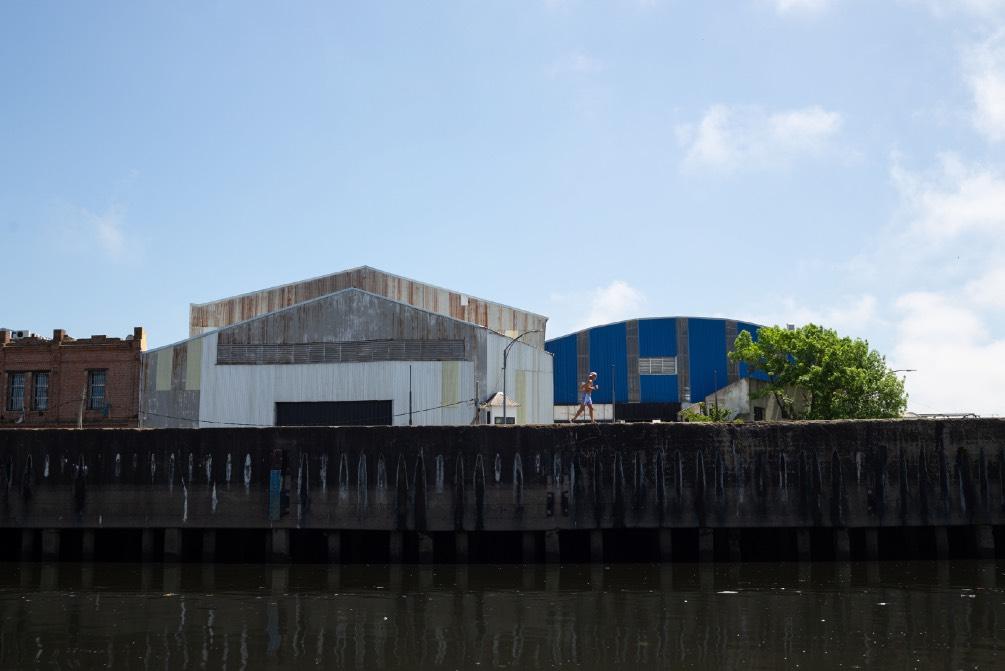
Dream of the River
It is a river and also it is a changing being. A vivid and complex being. I like the idea that the river dreams—not only its own course but also all beings that live or pass through there, in its waters and skies. Buenos Aires has been built around this river, it’s its emanation. This is why I came to believe the fate of the Riachuelo is closely related to the one of the city and the country. The dream of the river is also a nightmare. This river is on the edges of civilisation, where unpredictable future are being invited and where death seems to speak. Here healing is needed as much as activism. Art in this context is pushed to it’s limit, it becomes really relevant and it is asked who does it serves? The dream we saw in the river is also made of millions of people dirt, trash, shit, pee, industrial waist, it is the result of digestion and transformation of our industrious bodies, this is why the dream is so dark sometime, it is not made of the nice thing we want. It is made of the things we reject. Because of this rejection I find it important to be here and also welcome the trouble. What’s happening in this river is terrifying but also slow and tranquil, sometime the river change colour or get in fire but most of the time the disaster is not spectacular: it’s polluted water passing by slowly.

Children and activist
Exclusion, poverty, exploitation, rejection are a fundamental part of the problem of environment, there is no ecology without social justice. The children who are growing here are strongly impacted by the materiality of the river (they have led in their blood) and the cultural-socialeconomical context (lack of horizons, care, access, respect…). (1) During one of the tours, on the second day, the boat was moving slowly across the water, while the spectators listen quietly to the text. Suddenly, a stone bounced on the water; it nearly hit the boat. The captain moved away from the bank to protect us. A child had throne a stone on us. The workers cleaning the river and driving our boat tell me after that children often throw stones at them for no apparent reason.(2)
Gerardo Montes de Oca, an art teacher and graffiti artist, collaborated with children and residents of Isla Maciel (where the stone came from) to create a large mural on the abandoned hangar facing La Boca (see above). The mural depicts children looking from Isla Maciel at La Boca. According to Gerardo, they represent that side of the river—the abandoned Isla Maciel. Inviting resident and tourist on the other side to reflect on the situation of the children here. Later, on Isla Maciel, with Gerardo and Ana Laura we look for the children, hoping to talk with them. The streets of Isla Maciel are strangely quiet—almost no cars, no people. This contrasts with the rest of the city, noisy and hyperactive. But the children are not here. Childhood is raw power, it’s life at it’s maximum, like the river, like the tornado. Its violence is without purpose, without distinctions. There are no plans but existing. Juan, from theatre Catalina who lives in the neighbourhood, tells me that children often throw stones at trains for no reason, for fun. When a stone hits, it slows down time, like in an accident, time stretch.and a gap opens. I think about the G8 (3) This giant gatherings of politicians representing the richest nations and happening behind barriers and anti-terrorist police. Activists are here to show the cause, but children are the cause itself—there’s no mediation; they are their own right and justice. Mediation is always problematic for activists: there are many risks in representing a cause—appropriation, or misrepresenting the real issues, taking away power from the oppressed… The kids are here are not defending a cause, they are simply sending back the violence. (4)
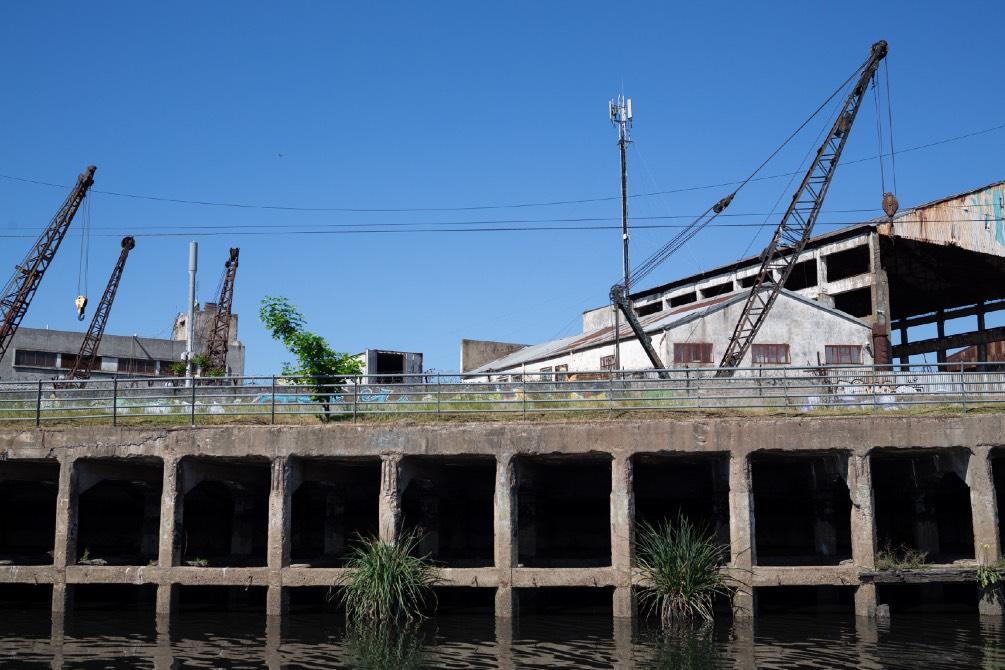
Sacrifice Zone
Sacrifice zones are areas of major ecological catastrophe caused by industrial activities. This concept was initially used to describe areas where farmers stored manure to protect the rest of the land from pollution. Indigenous Americans later adopted the term to define areas devastated by industries, often inhabited by poor and marginalised populations with little access to urban services (transport, sewage, water, electricity) or support. For many years, the Riachuelo is one of these zones, particularly the “Villa flammable” * (2). Navigating there I hear silence, something is suspended here. In ceremonial context sacrificing something is a way to connect to other worlds, to the underworld, the divine, the spirits or the dead… Our global culture doesn’t have this sens of the sacred maybe that’s also why it creates this sacrificed zones like the Riachuelo. But this place also become sacred, they open to an other world: the abandoned building, the emptiness and the pollution makes the river a portal to other dimensions and futures. It is an experience, where life communicates openly with death. The sacrifice of this zone, echoes the massive consumption, the excess, the noise the excitement made possible elsewhere. I read about the concept of “toxic uncertainty” (1) connected to living in polluted neighbourhood: Is my life in danger simply by being here? what does it mean to live with this toxicity?
*”Flammable: environmental suffering in an Argentine shantytown”(2008) by Auger and Swistun

Navigated by the River
Is this still a performance? Am I still capable of creating a performance? Is it not dangerous to do a performance? Is there not too much the risk of separating the vital experience from the act of creating? The risk of representing life rather than living it? The risk of professionalizing creation, of bourgeois appropriation? The risk of participating in the dissociation, increasing the loss of sensuality, encouraging the migration of humanity to more virtuality, negating it’s connection to itself and it’s environment… I fear to be simply feeding the absurd monster of the “society of spectacle,” that Debord denounced already before I was born. This is why I dream of an experience of the river. I crave for life celebration. An experience suspended in time, floating on the water. I dream that the river could be our guide and teacher. That the Riachuelo would open us to new ideas and possibilities. That it be our guide in the Anthropocene.
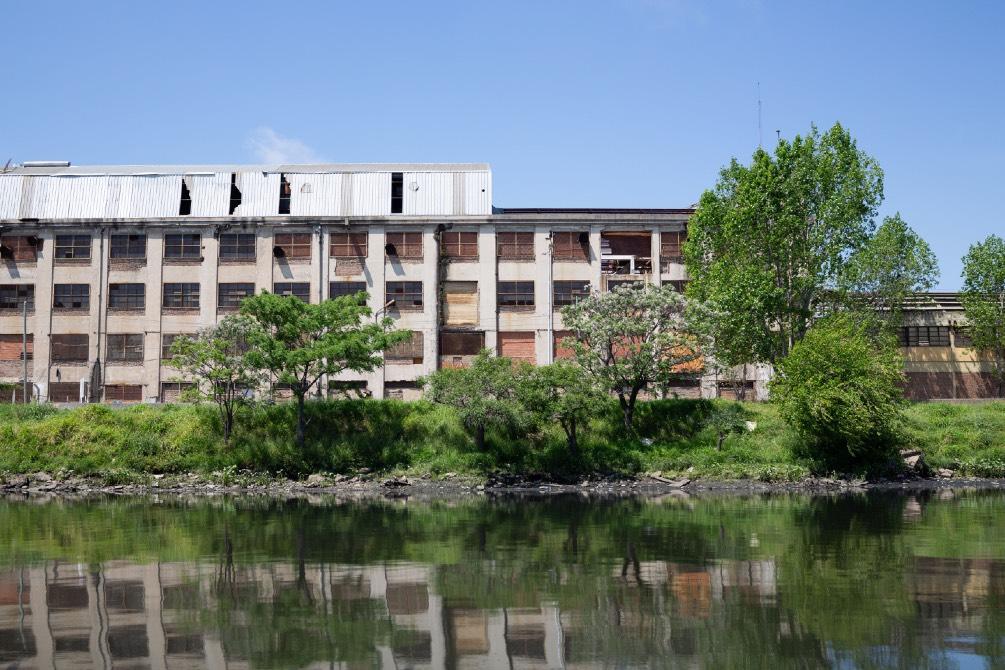
The Anthropocene?
Anthropocene means that the activities of human on earth have become the strongest geological force acting on it. As a fact it is true but also it implies that this massive changes of life on the planet is the fault of the entire humanity—which is not true, it would be blaming billions of people for the causes they are victims of. It’s like shaming the river for the pollution: only a very small fraction of humanity is responsible, decision makers, wealthy, industrials… Technological power allows us to transform earth, sea, and air at an unprecedented speed. That’s why some thinker propose rather calling this area the “Technocene”: technology is the primary driver of this changes into the new geological epoch. But the responsibility for these technological misuse comes from the ideology that make us live and use technic in this destructive manner. Indigenous cultures have lived in ways that respected their environment, this why we should speak of the “Capitalocene”: the relentless pursuit of profit and growth is producing these geological changes. Other authors have also spoken of the “Thanatocene,” because ecocide technologies were often developed first for war and then applied to environment (fertiliser was gun powder…). We could also speak of the Plantocene as those changes are connected to monoculture spreading all over the world since colonisation time. Each concept informs a certain perspective on what is producing the change. The conceptual tool of the “Cthulhuscene” is very helpful for me. The Cthulhuscene is not a description of a problem seen from outside but the process of engaging with the world, it explains that the problem is this view from above, this disconnection, and therefore it proposes attitude to create with the world and not find solution for a world outside of us, inviting us to “live with the trouble”. Ultimately, our era is a transition from the Holocene to an as-yet-unimaginable epoch.

Meditation on Death
The western culture in which I grew up suffers from a high level of dissociation, that is the result of traumatic experience called “freeze response”. Anyone who grew up in the global west is affected by this dissociation. There are various trauma passed on generation from generation. One of them is how we deal with death. When my mum died I realised the lack of care our cultures has for death and its process, we are unable to have healthy relation with the process of dying. Because death doesn’t have a place in our culture, when it comes, it comes along a lot of fear and denial. To understand how to heal from this frozen state, and grieve the death of my mum, I explored various therapeutic method, this is the subject of an other text. In this research, I realised that in the practices of health of many culture there is something regular to engage with mortality. Grieving regularly in collective ritual where to share pain, or in meditation.
Some very strong fear appear in the proximity of death. On the Riachuelo I feel this fears. There is a Tibetan and Hindu meditation called Chöd that involves visualisation of the fears. Fear appears as “demon” and “gods”. In India and Tibet the meditation is often practice in graveyard as it’s a place where fear of death arrises. What kind of fear is the Riachuelo emanating for me? I practice. In the visualisation process of the meditation I see the image of an old, drunk, sad man, loveless, alone. He has a very old turtle on his back, forever dying. He wants us to abandon life. He is ready to tear us appart. But behind that anger and sadness, he needs to be cherished, fed, celebrated. If he is fed he would straighten up, start to live, participate and help us. And the turtle would get wings and become a magic animal. He would dance undulating movement and feel so happy while the turtle would fly around him. I imagine feeding and cherishing this monster-river and seeing it transform into a white dragon carrying boats that resemble all kinds of animals.

Meditation on catastrophe
In the book by Lynn Margulis I am reading during this project, I learn about an ancient planetary catastrophe— two billion years ago, oxygen overproduction by bacteria created the “Great Oxidation”, which could have wiped out life of earth. At the time life was made of procaryotes (micro-organisme unicellular without nuclei), but instead of disappearing, life created new ways of inhabiting the world: it invented eukaryotic (cells with nuclei) and this led to the development of life forms we know today. The two main kingdoms of life—eukaryotes and prokaryotes—are intertwined in symbioses we barely start to understand. This microscopic universe is the chore of life; There is no fundamental difference between life within us and outside us. These invisible micro-organisms constitute the majority of life on the planet, shaping the air, earth, and oceans at the microscopic level and as well all bodies of animals.
On Monday afternoons, as the heat intensifies, the putrid odour of water becomes unbearable. The tension between my senses and the environment turns into an internal battle: I want to be elsewhere but have chosen to be here. This river carries the future. It invents the post-catastrophe to which I’m clearly not invited: this environment is hostile to my senses, but I’m staying, hoping to learn something.
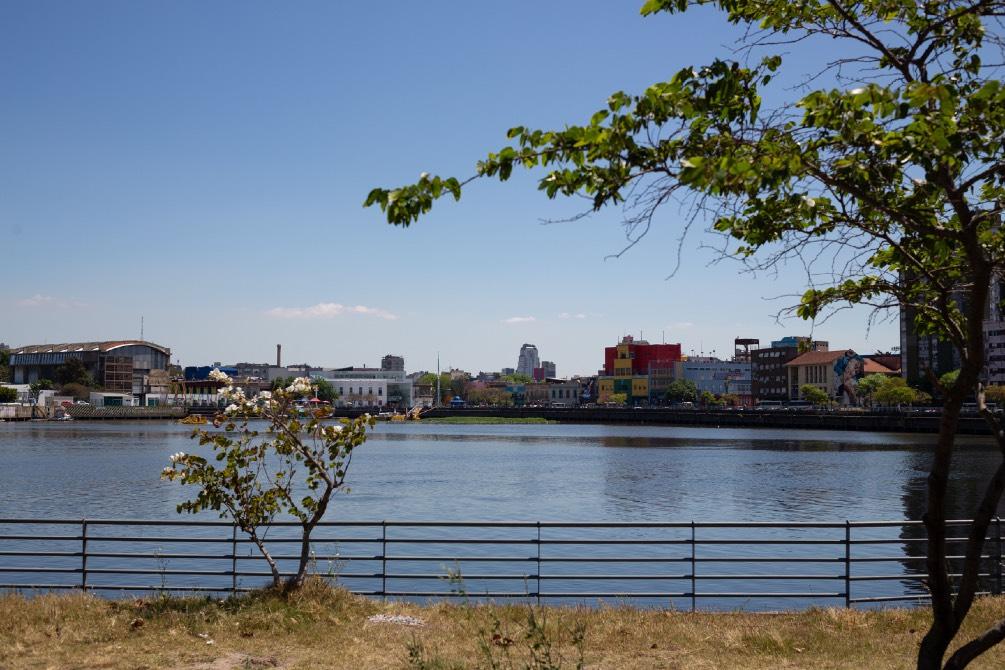
Pleasure
Its a nice sunny day, on the river, I feel connected to the water, in relation to the space, the light, through the wind on my skin, the sounds of birds, the gentle movement of the boat. It is a joy in being with, a pleasure that dancers knows, the body knows—the kinestesic pleasure-the pleasure of sensing in movement: it is not only good and pleasurable but also produces a sense of perfection that exists only in the very act of moving and sensing—a sense of being part of the space, participating in the world. Participating in the fundamental joyfulness, feeling included in the dance of the microscopic collectives that stirs creation at speeds and dimensions beyond thinking. Maybe this pleasure is the reasons for life to be. Pleasure justifies itself in the moment through its very experience. It has no other aim that itself; it is immediate, sensual, inscribed in the instant. I feel this with the river, and it connects me, it welcomes me into its dream. Our aesthetic sense is central for us to practice connecting to the non humxn. Pleasure is a sort of alignment with the presence. It arises with a dignity. It’s a sort of portal to connect and engage with this world, it’s a way to dialogue with non human beings.
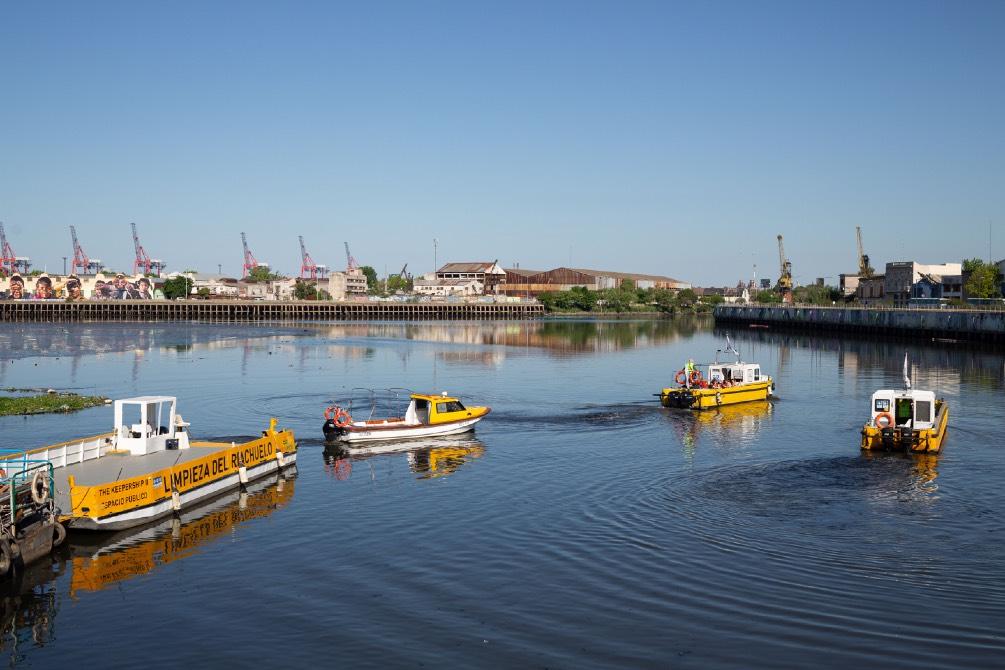
Acknowledgment
I’d like express my greatest gratitude to the team I worked with: Ana Laura López de la Torre for the precious support in dramaturgy, text and so much care for the river and the process, to Tammo Walter for being such a supportive and caring ally in the work and making it possible through production and management. And for taking the amazing pictures I use in this document. My deepest gratitude for Andrea Cuesta Ferrarazzo, who help us to meet and interview some great practitioners of the river, thanks to them: Marina Dogliotti - Sergio Biasotti - Silvana Canziani -Gerardo Momtes de Oca -Luciano Garramuño -Thank you to the team of the teatro de la Ribera, and very many thank you to Ileana Robles, Juan Barroso for such an amazing work at hosting the audience and the teatro Catalinas Sur who helped us to connect and who’s community work is so important. Thank you Fede Geller for the precious thinking and knowledge. Thank you so much to Ingrid Pelicori for lending her amazing voice to the river, and doing it with so much commitment and fun. I want to say thank you to the festival FIBA and the great team than made this possible particularly Rodrigo González Alvarado, Felicitas Oliden and Fer Cava. Thank you so much for the team of the Goeth institut BA, particularly Maren Schiefelbein for her patience and support to make this happen in changing times, for her curiosity and commitment, and thank you for the deep interest and support of Friso Maecker who’s belief in art work for changing time is so relevant now. Also thanks to the amazing team of people who clean the river in the section of La boca and that drove us on the boat with the audience daily into the river, their attention and sensitivity to the work was incredible and I’m pleased they took it with such a serious and attentive way.
credits
El Rio/ the river- Recreación para Buenos Aires - Adaptación: Clément Layes - Public in Private / Dramaturgia, textos: Clément Layes, Ana Laura Lopez de la Torre / Apoyo artístico: Andrea Cuesta Ferrarazzo, Jasna L. Vinovrški / Voce: Ingrid Pelicori / Sonido: Dan Peter Sundland / Anfitriones / guías: Ileana Robles, Juan Barroso / Producción creativa y giras: Tammo Walter / Agradecimientos: Marina Dogliotti, Sergio Biasotti, Silvana Canziani, Luciano Garramuño, Gerardo Momtes de Oca.
Creación en Berlín - Concepto: Aimé C. Songe - Public in Private / Colaboración artística: Jasna L. Vinovrški / Dramaturgia: Jonas Rutgeerts, Mila Pavićević / Música: Steve Heather / Anfitriones / guías: Asaf Aharonson, Zinzi Buchanan, Shannon Cooney, Clément Layes, Thiago Rosa / Diseño del bote: Jonas Maria Droste, Clément Layes / Vestuario: Malena Modeer / RR.PP.: Aïsha Mia Lethen Bird / Producción, supervisión: Tammo Walter, Tiphaine Carrère Loquet
the perfjoamcne was Supported by Goethe-Institut Buenos Aires and funds from the German Federal Foreign Office. Funded by the Berlin Senate Department for Culture and Europe and supported by Fonds Darstellende Künste with funds from the Federal Government Commissioner for Culture and Media within the program Neustart Kultur. Supported by Bureau Ritter.
Notes
1-I read about the complex feelings of many people living or raised in these sacrifice zones. The real daily hardship is compounded by stigmas and negative perceptions from others people living in more privileged conditions. Identification to this is low self-esteem, a difficulty to mentally leave the place long after physically leaving it. I do not want to reinforce negative images of the river and its inhabitants. Instead, I want to question what appears there—under a particular intensity.
2-In fact, this is not the first time I have been throne stones in an artistic setting. It happened also during an artist residency at the Rilleux la Pape choreographic center in 2006. During the presentation evening of our group ALS, neighbourhood youth threw stones at the building’s doors —so much so that we had to close the iron shutters for protection. A few years later, the wooden building of the CCN was built and then burned down. After this experience at the Riachuelo, Ana Laura recommended I read Denis Merke’s memoir: *Why Do We Burn Libraries?* That explains the sociology behind this. I recommend it. There is fire and stones between culture and these “sacrifice zones.”
3-In Andreas Malm’s book *How to Sabotage a Pipeline,* I find questions about the non-violent limits of ecological activism and the boundaries of those limits: what pollutes this water is a slow, ongoing assault. It is not just a problem of the river but of urbanization, territorial management, industry regulation, overexploitation… Six million residents near its banks, “villages” without sewage or sanitation systems, ten thousand industries without wastewater fi ltration. Contamination has become structural, part of the scenery; it has become normalized. It nourishes injustice and exploitation.
4-I feel on the wrong side of history—on the side of oppression and power. Despite my ideals and convictions, I am the one children throw stones at. Art is caught between two antagonistic sides —it has to deal with the elite and the marginalised, itself sometime cornered. Artists always risk appropriating social issues for personal gain, without truly advancing the causes they claim to support. The stone thrown by the child reveals this tension. At that moment, the complex and fragile structure resulting from the assembly of actors—artists, festival, funders, government, Ministry of Culture—is threatened because the neighbourhood children are not on the boat. A breach opens within me, but also symbolically everywhere on the planet. That stone signifies the failure of art as a radiant, humanising, spiritual force. Suddenly, the frightening abyss appears between these values and these acts.
Links
On the Riachuelo
https://agendarweb.com.ar/2025/03/28/algo-huele-mal-en-el-riachuelo-la-destruccion-deacumar/
https://www.andaragencia.org/el-riachuelo-uno-de-los-problemas-ambientales-mas-graves-delmundo/
https://noticiasambientales.com/environment-en/after-10-years-aysa-has-completed-theriachuelo-system-the-impact-of-the-long-awaited-project/
https://pulitzercenter.org/stories/there-still-hope-latin-americas-most-toxic-river
Icla Maciel
https://tn.com.ar/sociedad/2024/01/21/pinto-la-isla-los-vecinos-de-maciel-levantan-murales-yorganizan-tours-contra-los-estigmas/
the river on the Riachuelo
https://www.lanacion.com.ar/espectaculos/teatro/apertura-del-fiba-2024-la-ciudad-desconocidaque-se-ve-desde-las-aguas-y-una-noche-con-cuerpos-en-nid19102024/
https://www.lanacion.com.ar/espectaculos/teatro/apertura-del-fiba-2024-la-ciudad-desconocidaque-se-ve-desde-las-aguas-y-una-noche-con-cuerpos-en-nid19102024/
https://www.pagina12.com.ar/775825-the-river-un-viaje-sensorial-por-el-riachuelo
https://www.nueva-ciudad.com.ar/notas/202410/54935-arranca-el-fiba-el-festival-de-teatro-debuenos-aires.html
https://kamonline.com.ar/articulo/de-un-paseo-por-el-riachuelo-a-un-recorrido-por-un-hotelalojamiento-las-propuestas-mas-sorprendentes-del-fiba-2024.php https://palermonline.com.ar/wordpress/tres-celebradas-propuestas-internacionales-abriranfiba-2024/
https://www.clarin.com/suscripciones/landing-apw.html?apworigin=https%3A%2F%2Fwww.clarin.com%2Frevista-n%2Finusual-experiencia-fiba-paseoriachuelo_0_2mMzAto6sw.html&wb=PW_HPW_ZONDA
https://www.goethe.de/ins/ar/es/sta/bue/ver.cfm?event_id=26107274
https://culturagcba.clientes.ejes.com/noticia_completa.cfm?id=91539911
https://culturagcba.clientes.ejes.com/noticia_completa.cfm?id=91540052
https://culturagcba.clientes.ejes.com/noticia_completa.cfm?id=90979365
https://lavereda.com.ar/el-fiba-2024-inicia-con-destacadas-propuestas-internacionales/ https://docs.google.com/spreadsheets/d/ 1KQOfK8wXUSZ3H9e8SeDPLKbTpTvR6Vznp5y9voledws/edit?gid=0#gid=0
